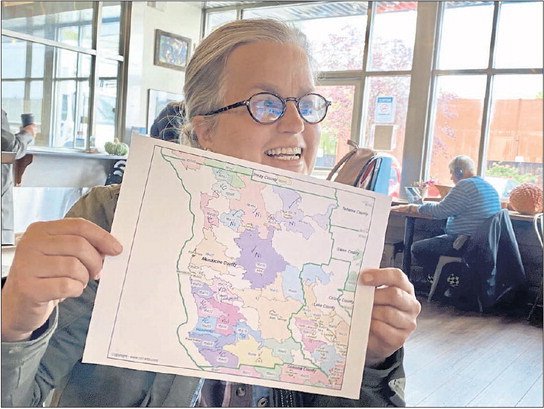
On Sunday November 14, the Ukiah Daily Journal, and associated newspapers, ran the following article penned by freelance journalist Carole Brodsky. This article is the first of three planned articles that will examine the history and future of broadband in Mendocino County. As the pandemic showed, the lack of connectivity puts our county at an economic disadvantage.
Road to the Last Mile
By Carole Brodsky, Ukiah Daily Journal
Part One: ConnectUp Mendocino
For over a decade, a consortium of state and local government, volunteers, local and regional non-profit organizations and educational institutions have been meeting to address the enormous challenge of boosting the county’s internet connectivity level- with the goal of bringing Mendocino County into the 21st century.
In this three-part series, the Ukiah Daily Journal will be covering the vast subject of broadband and how the lack of robust internet service has hampered, frustrated and in some cases even endangered Mendocino County citizens. The series begins with a request: taking a crowd-sourced speed test to assist the Broadband Alliance of Mendocino County. The test will help identify the county’s most underserved areas and will help qualify for funding to bring substantial broadband services to the thousands of un-or-underserved households throughout the county.
The “ConnectUp Mendocino†campaign kicked off in late October, facilitated by the West Business Development Center. The project is a group effort of the County of Mendocino, the West Business Development Center, the Community Foundation of Mendocino County, and the Broadband Alliance of MendocinoCounty. “One lesson learned from the pandemic was that there are five pillars- education, public safety, commerce, government and health care- all of which were greatly impacted because of our countywide digital divide,†notes Paloma Patterson, West Business Center’s Business Development Manager
“We are encouraging as many people to take the speed test as possible,†says Patterson. “Federal and State funds are coming our way for infrastructure that will improve county connectivity, particularly for what is called the ‘middle mile,’†she continues. The middle mile is the geographical area tangential to major thoroughfares like the Highway 1 & 101.
According to Jeff Tyrrell, administrator for the Broadband Alliance of Mendocino County, the speed test provides a good opportunity to engage and educate the public, and to accurately map the enormous service gaps that continue to exist. “Mendocino County is currently the eighth-to-the-last county in California in terms of the percentage of people who have broadband access,†Tyrrell explains. The Consortium has been actively involved in the Mendocino County Digital Infrastructure Project Plans. Developed throughout 2019-2020, the project designs are 3 sequential grant applications, intended to expand internet access, and help the State meet its goal of broadband availability to 98% of households by 2025. While Mendocino County’s CASF grants remain pending, SB 156 has passed and will provide significant funding to the same goals.
SB 156 provides $3 billion for the building of an open access ‘middle mile,’ $1 billion for rural ‘last mile’ networks, and $1 billion for ‘last mile’ networks throughout the urban counties.
The ‘last miles’ of Mendocino County are the roads to the rural hamlets and small coastal communities that comprise the bulk of internet-deprived populations; funding their connectivity is most challenging. Still, for the first time since the inception of the Broadband Alliance, funding appears to be on the horizon for both completion of middle-mile and essential last mile services.
A patchwork of several substantial funding sources including SB156 will refocus local efforts toward the development of a middle-mile network consisting of fiber optic cables along 100+ miles of Highway in Mendocino County. Likewise, substantial funds are dedicated to the cost of ‘last mile’ services along our county roads. Data from the speed test is essential to the pursuit of supplementary grants and will help prove the case for the overwhelming need for more ubiquitous, robust service.
One of the best ways to justify the need for last mile funding is by demonstrating poor or in some cases, complete lack of connectivity. “The West Business Development Center came in to help promote the county speed test,†says Patterson. “The County is crowd-sourcing data, which includes internet service, by location and relative speed,†she continues. “Outreach is focused on reaching people in underserved areasto test their connectivity or to document households that don’t have internet at home- or that speeds are super-slow,†she continues.
Though the project is not excluding participation from Mendocino County cities such as Fort Bragg, Willits and Ukiah, the primary focus of the speed test is engaging residents of the surrounding countryside and unincorporated areas of the county.
“We’re focusing on people who live off county roads- people who live off of 253 and 128, residents of Philo, Potter Valley, Comptche, Brooktrails, Laytonville, the Sanel Valley, Albion, Covelo, Dos Rios, Gualala, Leggett, Redwood Valley, Westport, Cleone, Elk, Manchester, Boonville, Yorkville and everything in between,†notes Adriana Dakin, who is coordinating community and social media outreach for the campaign. Unlike earlier speed test projects, Dakin is employing a variety of social media efforts and the support of local influencers to get the word out.
Taking the speed test is about a three-minute process. It can be taken from a computer, tablet or mobile phone. It is important to stop streaming videos and gaming while the speed test is taking place, as well as turning off VPN during the test.
“Take the test at your home. You may use the GPS location included in the test or just type in your address. If you don’t have Internet service, go to your closest library and enter your exact home address. The idea is we want to identify the exact areas that are un-served and underserved,†says Patterson. Businesses may take the speed test as well, says Tyrrell. “Doing it on the commute between home and work using your phone. If you have a place where you get cell service on a pullout, that could be very useful in designing the last mile iteration, particularly if there was a faint signal in a particular area that could be augmented. We don’t need just your house or your business location. Take the test everywhere you go.â€
But funding, notes Tyrrell, will come down in large part to the collection of residential data, which is being collated by the County of Mendocino. The creation of a community map that clearly demonstrates the lack of broadband in underserved areas is an immediate public benefit.
“We want to focus on areas that need the most help. This is an economic development issue,†says Alison de Grassi, Director of Marketing for the West Business Development Center. “Without robust connectivity, we can’t get businesses to come here. More people are moving here. They may not realize we do not have the kind of connectivity they’ve become used to in the Bay Area.â€
A map and data sheet displaying the current test results is available for viewing on the Speed Test site. To date, 1,700 tests have been conducted in 1,477 unique locations.
Tyrrell emphasizes that no private information will be collected as part of the testing. “What will be collected is the location of the test, the name of your Internet service provider, the number of subscribers who have taken the test and the actual up-and-download times recorded,†he notes.
According to Tyrrell, there are several options for taking the test for those who have privacy concerns. “You can enter a partial address, but if your equipment permits, you can enter GPS coordinates. In that case, your ‘dot’ on the map will be randomly moved around to protect your anonymity. If you visit the map multiple times and go to an exact spot, corresponding dots will be randomly moved and re-mapped to protect privacy. ‘Up and down’ speeds are not linked to a name or any person,†Tyrrell continues.
The test will be running through December of this year. Participants may take the test more than once, but the effectiveness of this exercise will be based on the number of individual addresses that participate.
The next installment of the series will consist of a discussion with Broadband Alliance administrator, Jeff Tyrrell, 5th District Supervisor Ted Williams and co-founder of the Broadband Alliance, Jim Moorehead.
Visit tinyurl.com/mendospeedtest to take the test and view the current data map.
To learn more about the Broadband Alliance of Mendocino County visit https://www.mendocinobroadband. org

